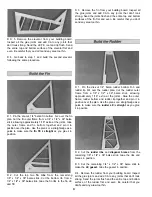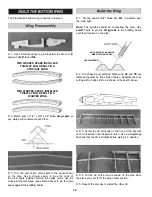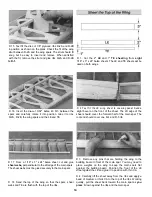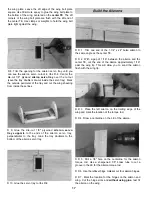
There are two types of screws used in this kit.
Sheet metal screws are designated by a number and a
length. For example #6 x 3/4"
D 1. Unroll the plan sheets Reroll the plan sheets inside
out to make them lie flat Place wax paper or Great Planes
Plan Protector over the plan to prevent glue from sticking to
the plan.
Machine screws are designated by a number, threads per
inch and a length. For example 4-40 x 3/4"
When you see the term "test fit" in the instructions, it
means you should first position the part on the assembly
without using any glue and then slightly modify or sand
the part as necessary for the best fit
Whenever the instructions tell you to glue pieces together,
CA or epoxy may be used When a specific type of glue is
required, the instructions will state the type of glue that is
highly recommended. When 30-minute epoxy is specified,
it is highly recommended that you use only 30-minute (or
slower) epoxy because you will need either the working
time or the additional strength.
D 2 Remove all parts from the box As you do, determine
the name of each part by comparing it with the plan and
the parts list included with this kit Using a felt-tip or
ballpoint pen, lightly write the part name or size on each
piece to avoid confusion later Use the die-cut patterns
shown on pages 6 and 7 to identify the die-cut parts and
mark them before removing them from the sheet Save all
scraps If any of the die-cut parts are difficult to remove, do
not force them' Instead, cut around the parts Use your
Easy-Touch Bar Sander or sanding block to lightly sand
the edges to remove any die-cutting irregularities.
D 3. As you identify and mark the parts, separate them
into groups, such as fuse (fuselage), wing, fin, stab
(stabilizer) and hardware Resealable food storage bags
are handy to store parts in as you sort, identify and
separate them into subassemblies.
Several times during construction we refer to the "top" or
"bottom' of the model or a part of the model For example,
during wing construction we tell you to "glue the top main
spar" or "trim the bottom of the former" It is understood that
the "top" or "bottom" of the model is as it would be when the
airplane is right side up and will be referred to as the "top"
even if the model is being worked on upside-down (i e the
"top" main spar is always the 'top" main spar, even when
the wing is being built upside-down).
Inch Scale
Metric Scale
5






































